Louis Vuitton’s packaging exemplifies luxury and innovation, combining diverse box styles, premium materials, and thoughtful design elements to enhance the consumer experience while reflecting the brand’s identity. The packaging includes rigid boxes for durability, collapsible boxes for space efficiency, and drawer-style boxes for a tactile unboxing experience, all crafted with high-grade cardboard, coated paper, and fabric inserts, ensuring both quality and aesthetic appeal. Notably, Louis Vuitton incorporates eco-friendly materials, demonstrating a commitment to sustainability. The packaging’s design, featuring signature patterns and timeless color palettes, reinforces brand recognition and exclusivity. Beyond protection, it serves as a strategic tool for consumer engagement and emotional connection, setting benchmarks in luxury brand packaging. Manufacturers seeking inspiration can leverage these principles to align packaging aesthetics with brand identity, prioritize quality, and integrate sustainable practices, thus creating packaging that resonates with consumers on both functional and emotional levels.
What Box Styles Are Used in Louis Vuitton Packaging?
The box styles used in Louis Vuitton packaging are given below:
Rigid Boxes
Rigid boxes are a cornerstone of Louis Vuitton’s packaging design, primarily used for larger items such as handbags and shoes. These boxes feature a robust double-walled construction that prevents deformation and ensures durability during transit. Their structure provides optimal protection while maintaining an elegant appearance, perfectly aligning with the brand’s luxury image.
Collapsible Boxes
Collapsible boxes are designed for smaller accessories, offering a space-efficient solution that retains structural integrity. These boxes utilize interlocking panels for easy assembly and disassembly, allowing for streamlined storage and transportation. The collapsible design reflects Louis Vuitton’s commitment to functionality without compromising aesthetic appeal.
Drawer-Style Boxes
Drawer-style boxes are frequently used for jewelry and small leather goods, incorporating a sliding mechanism that enhances the unboxing experience. These boxes often feature ribbon pulls or embossed handles, adding a tactile element that elevates consumer interaction. Their thoughtful design exemplifies Louis Vuitton’s attention to detail and dedication to creating memorable packaging experiences.
What Materials Are Used in Louis Vuitton Packaging?
The materials used in Louis Vuitton packaging are mentioned below:
High-Grade Cardboard
High-grade cardboard is the cornerstone of Louis Vuitton packaging. This material provides the structural foundation for most box styles, ensuring rigidity and resistance to external pressures. Its robust nature supports the brand’s commitment to quality and durability, protecting products during transport and storage.
Coated Paper
Coated paper is a key element in Louis Vuitton packaging, often adorned with the iconic monogram or Damier pattern. This material delivers a smooth, luxurious finish that enhances visual appeal and reinforces brand recognition. The coating also adds a level of moisture resistance, preserving the integrity of the packaging.
Fabric Inserts
Fabric inserts, such as velvet or microfiber, are used to line the interiors of Louis Vuitton boxes. These materials provide cushioning and protection for products, while simultaneously contributing to the sensory experience of the unboxing process. Their tactile quality aligns with the brand’s emphasis on luxury and attention to detail.
Eco-Friendly Materials
In recent years, Louis Vuitton has integrated eco-friendly materials into its packaging, including recycled cardboard and water-based inks. These sustainable choices reflect the brand’s commitment to environmental responsibility without compromising the high standard of quality and elegance that defines its packaging.
How Can Manufacturers Draw Inspiration from Louis Vuitton Packaging?
Manufacturers seeking to create high-end packaging solutions can draw inspiration from Louis Vuitton’s approach to design and material selection. Key takeaways include the importance of aligning packaging aesthetics with brand identity, the use of premium materials to enhance perceived value, and the incorporation of functional features that elevate the consumer experience.
For example, manufacturers can adopt Louis Vuitton’s practice of using signature design elements to create a distinctive visual identity. They can also explore the use of eco-friendly materials, such as recycled cardboard and biodegradable coatings, to meet sustainability goals. Additionally, integrating features like magnetic closures or fabric inserts can enhance the tactile and visual appeal of packaging, making it more memorable for consumers.
What Are the Broader Implications of Louis Vuitton Packaging Design?
The design principles underlying Louis Vuitton packaging have broader implications for the packaging industry, particularly in the context of luxury branding. By prioritizing quality, sustainability, and consumer engagement, Louis Vuitton sets a benchmark for packaging that goes beyond mere functionality. This approach highlights the potential of packaging to serve as a strategic tool for brand differentiation and value creation.
For manufacturers, the success of Louis Vuitton packaging underscores the importance of investing in design innovation and material research. It also demonstrates the value of creating packaging that resonates with consumers on an emotional level, fostering brand loyalty and enhancing the overall product experience. As the packaging industry continues to evolve, the principles exemplified by Louis Vuitton offer valuable insights for navigating the challenges and opportunities of modern packaging design.

